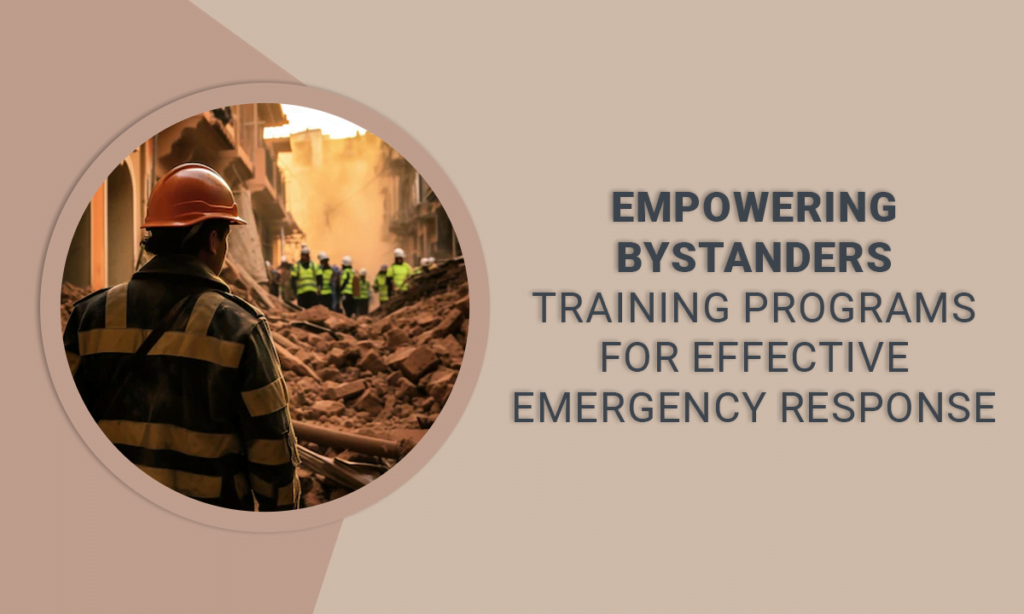In the critical moments following an emergency, the actions of bystanders can mean the difference between life and death. With emergency services often minutes to hours away, especially in remote or congested areas, empowering ordinary citizens through training programs is becoming increasingly important. This blog post explores the significance of bystander training programs, the various initiatives being undertaken, and the profound impact these can have on society’s capacity for emergency response.
The Crucial Role of Bystanders in Emergencies
Bystanders are typically the first on the scene in an emergency. Their immediate response can stabilize a situation, provide crucial care, and bridge the gap until professional help arrives. However, without proper training, bystanders may feel helpless or unsure of how to act, potentially leading to a loss of precious time.
Bridging the Response Gap
Training programs equip bystanders with the knowledge to perform essential first aid, use an automated external defibrillator (AED), and carry out life-saving techniques like the Heimlich maneuver or cardiopulmonary resuscitation (CPR). This training turns passive onlookers into active lifesavers.
Creating a Chain of Survival
The concept of a ‘chain of survival’ emphasizes a series of actions that, when performed in sequence, can significantly improve the chances of survival following cardiac arrest. Bystander intervention is the first link in this chain, highlighting the importance of immediate response.
Initiatives in Bystander Training
Across the globe, various programs have been initiated to train bystanders in emergency response. These range from community workshops to comprehensive online courses.
Community CPR Workshops
Organizations such as the American Heart Association and the Red Cross have been instrumental in providing CPR training to the public. Similar initiatives in other countries have also gained momentum, often supported by healthcare providers and local governments.
First Aid and AED Training
First aid training goes beyond CPR, teaching individuals how to manage a range of medical emergencies, including bleeding, fractures, and burns. AED training is also becoming more common, with public access defibrillators being installed in many areas.
School Programs
Integrating basic life support training into school curriculums ensures that even young people have the skills to respond in an emergency. These programs foster a culture of readiness and responsibility from an early age.
Online Learning Platforms
The rise of online learning platforms has made emergency response training more accessible. These platforms offer the flexibility for individuals to learn at their own pace and often provide resources for practical skill assessments.
The Impact of Training on Society
The widespread training of bystanders has a ripple effect on society, enhancing overall safety and preparedness.
Increased Survival Rates
Regions with higher rates of bystander CPR training have reported increased survival rates from sudden cardiac arrest. This is a direct testament to the effectiveness of such training programs.
Community Empowerment
When community members are trained to handle emergencies, it fosters a sense of empowerment and confidence. It also strengthens community bonds, as people come together to learn how to take care of one another.
Reducing the Burden on Emergency Services
Effective bystander response can reduce the immediate burden on emergency services, allowing them to manage resources more efficiently and focus on the most critical cases.
Encouraging a Proactive Public Health Approach
Bystander training is a proactive approach to public health. It prepares communities to prevent emergencies from becoming fatalities, reflecting a shift from reactive to preventive healthcare.
Challenges and Opportunities in Bystander Training
While the benefits are clear, there are challenges to implementing widespread bystander training, as well as opportunities for innovation and growth.
Overcoming Hesitation
A common challenge is the hesitation or fear of doing more harm than good. Training programs must address these concerns, emphasizing the Good Samaritan laws that protect bystanders who act in good faith.
Accessibility and Inclusivity
Making training accessible to people of all ages, backgrounds, and abilities is crucial. This includes offering courses in multiple languages, ensuring physical accessibility, and considering the diverse learning needs of participants.
Leveraging Technology
Virtual reality (VR) and augmented reality (AR) offer new ways to simulate emergency scenarios, providing immersive training experiences. These technologies can enhance learning and retention of life-saving skills.
Continuous Education and Practice
Emergency skills can fade without practice. Offering refresher courses and creating opportunities for regular practice, such as community drills, can maintain skill levels and readiness.
Conclusion: A Call to Action for Lifesaving Education
The empowerment of bystanders through training programs is a critical component of a responsive and resilient healthcare system. By equipping individuals with the skills to act promptly and effectively in emergencies, we can transform society into a collective force for emergency response.
As we continue to advocate for and implement these training programs, we must also innovate and adapt to the changing landscape of education and technology. The goal is clear: to create a world where every individual has the knowledge and confidence to save a life.
This call to action is not just for healthcare professionals or policymakers; it is a call to every member of society. Whether it’s signing up for a first aid course, learning CPR online, or participating in a community drill, each step taken is a step towards a society where timely assistance in emergencies is not just a matter of chance, but a common reality.
In empowering bystanders, we are not just teaching life-saving skills; we are nurturing a culture of care, vigilance, and community responsibility. Let’s embrace this empowering journey, for the life you save with your knowledge and skills could be that of a loved one, a friend, or a neighbor.
People Also Read: Dr. B.R. Ambedkar: Architect of the Indian Constitution and Champion of Social Justice

Pingback: Rising Above Tradition: The Young Voices Fighting Child Marriage in India - Sankalp Bhoomi Trust